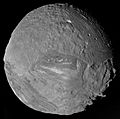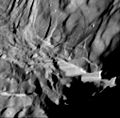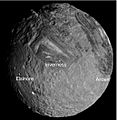Miranda (moon) facts for kids
Miranda is one of Uranus' moons. It is the smallest, and the one which has the least rotation time. Gerard Kuiper discovered it in 1948 and named it after Miranda, Prospero's daughter in William Shakespeare's play The Tempest. Sometimes it is also called Uranus V.
It's one of Uranus' strangest moons. Its complex surface may indicate partial melting of its interior, with icy material drifting to the surface.
The probe Voyager 2 made some photos in 1986. These are the only images that exist, so far. Geologically, it is the most active body in the Uranus system. The grooves and troughs reach depths of a few kilometers (or miles) and expose materials of different albedos (reflectivity). The features suggest a long, complex geologic evolution of this satellite.
Images for kids
-
Voyager 2 image of Miranda's broken terrain. Verona Rupes, thought to be the highest cliffs in the Solar System, are located at the bottom right of Miranda.
-
Close-up of Verona Rupes, a large fault scarp on Miranda possibly 20 km (12 mi) high, taken by Voyager 2 in January 1986
See also
 In Spanish: Miranda (satélite) para niños
In Spanish: Miranda (satélite) para niños








